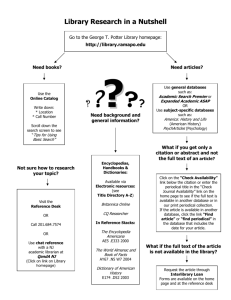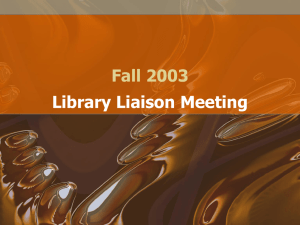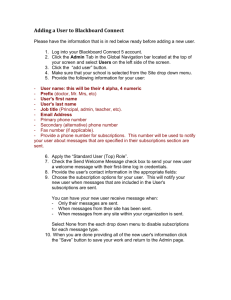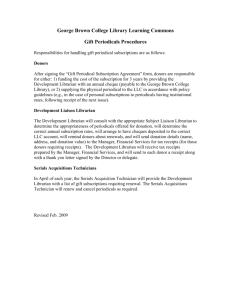PROGRAM REVIEW, ALLOCATION, AND INSTITUTIONAL STRATEGIES FOR EXCELLENCE (P.R.A.I.S.E.) REPORT
advertisement
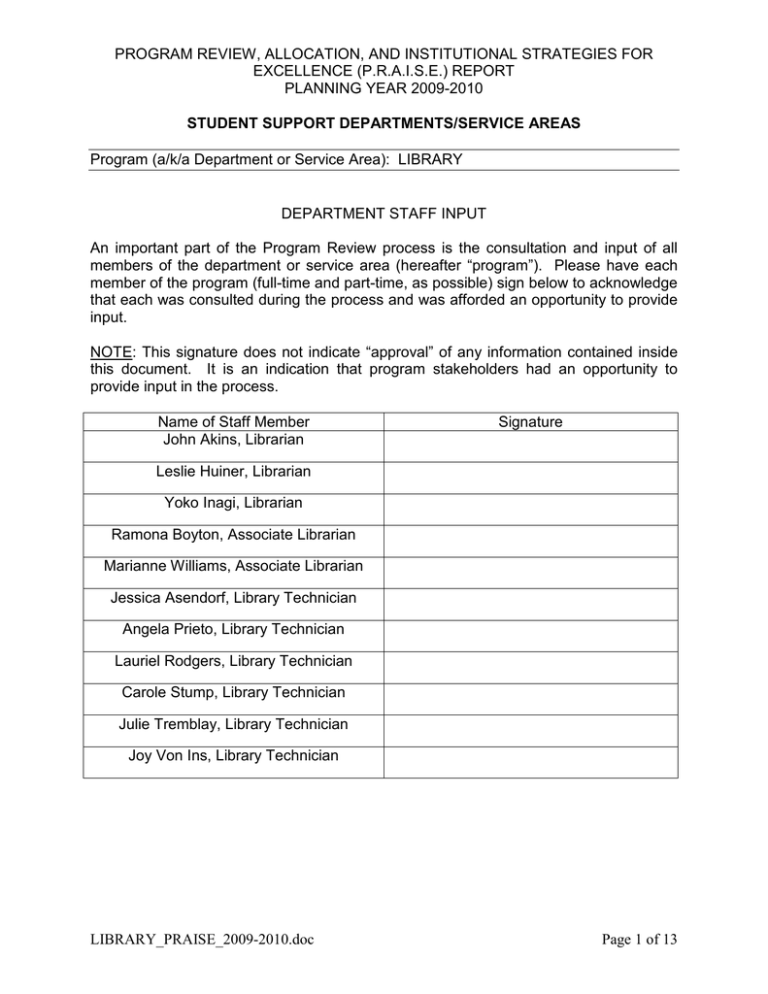
PROGRAM REVIEW, ALLOCATION, AND INSTITUTIONAL STRATEGIES FOR EXCELLENCE (P.R.A.I.S.E.) REPORT PLANNING YEAR 2009-2010 STUDENT SUPPORT DEPARTMENTS/SERVICE AREAS Program (a/k/a Department or Service Area): LIBRARY DEPARTMENT STAFF INPUT An important part of the Program Review process is the consultation and input of all members of the department or service area (hereafter “program”). Please have each member of the program (full-time and part-time, as possible) sign below to acknowledge that each was consulted during the process and was afforded an opportunity to provide input. NOTE: This signature does not indicate “approval” of any information contained inside this document. It is an indication that program stakeholders had an opportunity to provide input in the process. Name of Staff Member John Akins, Librarian Signature Leslie Huiner, Librarian Yoko Inagi, Librarian Ramona Boyton, Associate Librarian Marianne Williams, Associate Librarian Jessica Asendorf, Library Technician Angela Prieto, Library Technician Lauriel Rodgers, Library Technician Carole Stump, Library Technician Julie Tremblay, Library Technician Joy Von Ins, Library Technician LIBRARY_PRAISE_2009-2010.doc Page 1 of 13 PROGRAM REVIEW, ALLOCATION, AND INSTITUTIONAL STRATEGIES FOR EXCELLENCE (P.R.A.I.S.E.) REPORT PLANNING YEAR 2009-2010 STUDENT SUPPORT DEPARTMENTS/SERVICE AREAS Program (a/k/a Department or Service Area): LIBRARY PART I. ABSTRACT (EXECUTIVE SUMMARY). In one page or less, summarize the major findings of the program review in terms of strengths, weaknesses, opportunities and threats. Provide a brief explanation of any evidence based on industry standards, reports or other data used, and the intended impacts supported by your action plan and/or budget augmentation requests for the relevant planning year. Summary of Strengths and Supporting Evidence: The library meets the needs of all campus disciplines and serves the local community as the only academic library in the high desert area. It is an integral component of student learning and success as evidenced by its information competency program, which is a general education learning outcome and graduation requirement for the associate degree. The library’s mission is to support the academic success of VVC students by providing instructional services and information resources to meet their research needs. Supporting evidence is found in usage, collection and instruction statistics described in Part II KQMs. Summary of Improvements Needed and Supporting Evidence: The library will not be able to provide basic learning resources or meet accreditation guidelines if funding eliminated in the 2009-10 year for online databases, books and periodicals is not restored in the 2010-11 fiscal year. Supporting evidence is found in usage, collection and instruction statistics described in Part II KQMs. Summary of Annual Plan Goals and Justification of Augmentation Requests: The library’s goals for 2010-11 are to maintain a high quality learning resource center for students, including effective instructional services, technological infrastructure, and an adequate collection of information resources. PART II. KEY MEASUREMENTS OF QUALITY (KQMs). Key quality measurements (KQMs) are those of particular importance to each program. KQMs are organized under five (5) categories: Demand/Relevance: This information should explain how the program’s services and activities meet the demands or needs of students and the community. Address the program’s continuing efforts to ensure that key services are (a) relevant to student needs and established college priorities (see last page of this template); (b) have clear linkages to student learning and development; and (c) communicated clearly to all program stakeholders (students, staff, community). LIBRARY_PRAISE_2009-2010.doc Page 2 of 13 PROGRAM REVIEW, ALLOCATION, AND INSTITUTIONAL STRATEGIES FOR EXCELLENCE (P.R.A.I.S.E.) REPORT PLANNING YEAR 2009-2010 STUDENT SUPPORT DEPARTMENTS/SERVICE AREAS Program (a/k/a Department or Service Area): LIBRARY The library provides instructional services, materials, facilities, and technology for students and faculty to support their learning and teaching needs. Librarians are available at the reference desk during all hours of operation to assist students with locating and using information resources. The library supports the campus-wide general education information literacy learning outcome through a mandatory library instruction session and hands-on workbook that is required curriculum for all English 101 students. This workbook is designed to teach students information competency skills related to locating, evaluating and using both print and electronic information sources through a combination of library literacy, research methods and technological skills. Library instruction is offered to courses across the curriculum with demonstrations of information resources relevant to the subject matter and research assignments. Workshops have been held to familiarize faculty with the library’s electronic resources. As detailed in the annual California Academic Library Report for 2008-2009, materials in the collection included: 56,437 books, 285 periodical subscriptions, 4,849 videos, 6,091 audio recordings, and 14 online periodical/reference database subscriptions. Course reserve materials, such as textbooks, videos, and supplemental readings, are also available to students. The library’s website acts as a portal for information sources including: online catalog of book, periodical and media holdings; full-text periodical databases and reference sources; research tools and instructional handouts; subject research guides; examples of standard citation formats; recommended Internet sources; and links to other libraries. Support for distance learners and off-campus students is provided by web access to the online catalog, and remote access via a username/password to full-text periodical and reference databases. The library has a copy room, typewriters, microfiche/film reader-printers, and quiet group study rooms. A computer with assistive technology is available for students trained through the DSPS program. The library has a unique Local History Collection with books, manuscripts, maps, oral histories, photographs, and other rare materials on the Victor Valley and high desert area. The library retains a membership in the Inland Empire Academic Libraries Cooperative, which provides VVC students with borrowing privileges at other college libraries in San Bernardino County area, including CSU San Bernardino. Interlibrary loan is available for students and faculty. As the only academic library in the high desert, our library also serves the local community and K-12 students. Community residents are able to obtain borrowing privileges by joining the “Friends of the Library” for a $12 annual fee. Process Management: This information should explain how the program’s key business processes and work systems are (a) linked to student learning and LIBRARY_PRAISE_2009-2010.doc Page 3 of 13 PROGRAM REVIEW, ALLOCATION, AND INSTITUTIONAL STRATEGIES FOR EXCELLENCE (P.R.A.I.S.E.) REPORT PLANNING YEAR 2009-2010 STUDENT SUPPORT DEPARTMENTS/SERVICE AREAS Program (a/k/a Department or Service Area): LIBRARY development; (b) evaluated and improved to ensure relevance and quality control; and (c) communicated clearly to program stakeholders. The library’s key business processes include working with book, periodical, media and supply vendors who offer discounted pricing or aggregate services to save money and staff time in the acquisitions process. The library participates in the Community College League consortium for discounted pricing on database subscriptions. The library’s collection development policy ensures that resources are acquired to support student learning and curriculum. Librarians use reviews from professional trade publications such as Library Journal, Booklist and Publisher’s Weekly to select new materials. Selection factors include current holdings, circulation and usage statistics, relevancy to curriculum, and price. Recommendations come directly from faculty or may result from reference interactions with students. A librarian serves on the curriculum committee and the curriculum approval process requires faculty to review the library’s current holdings and recommend materials to support new and updated courses. Data reports from the Sirsi automation system provide statistics on circulation and materials holdings by call number (i.e. – subject) that are used to evaluate how the collection meets actual needs and areas where materials should be added. An annual inventory of the collection provides a measure for quality control: corrections can be made to update the catalog for missing items and adjustments made for mis-shelved or other problem items. When new materials are processed, faculty are advised via email of new holdings in their curricular areas. New books are advertised to students through displays, the library newsletter, and occasionally in the RamPage student newspaper. Students find library materials through the catalog and access online database subscriptions through the library’s web page. Available Resources: Base level of resources available to program in terms of funding/revenue; personnel; training/professional development; technology (computers, peripherals, software); equipment; supplies; space/facilities; other. The library’s budgets for online databases, periodicals and books were severely impacted by the elimination of statewide categorical and grant programs in the 20092010 fiscal year. The long-standing Telecommunications Technology Infrastructure Program (TTIP) from the Chancellor’s Office, which provided an annual $36,363 allocation for online database subscriptions, was abolished. At the same time, the LIBRARY_PRAISE_2009-2010.doc Page 4 of 13 PROGRAM REVIEW, ALLOCATION, AND INSTITUTIONAL STRATEGIES FOR EXCELLENCE (P.R.A.I.S.E.) REPORT PLANNING YEAR 2009-2010 STUDENT SUPPORT DEPARTMENTS/SERVICE AREAS Program (a/k/a Department or Service Area): LIBRARY library’s minimal general fund budget for online subscriptions was also reduced by 10%. The categorical state block grant known as “Instructional Equipment/Library Materials” was also eliminated, which meant a 100% cut to the library’s print periodical budget and a 55% reduction to the book budget. Due to the rollover policy of the TTIP grant, the library was able to use the balance of the 2008-09 fiscal year funds along with a portion of the 2009-10 general fund book budget to renew access to databases through next academic year. Eight of the database subscriptions will expire at the end of the fall 2010 semester, and the remaining 7 database subscriptions will expire at the end of the spring 2011 semester. VVC’s Title V Math/Science grant funded the renewal of the Proquest Biology database through December 2010. For the fiscal year 2010-2011, there is a critical need for the district to establish an ongoing general fund budget to replace the loss of the TTIP funding for databases. The Academic Senate for California Community Colleges passed a resolution at the fall 2009 plenary session urging districts to adequately fund electronic resources in community college libraries. As a result of the elimination of the printed periodical budget, the library’s periodical holdings were reduced from 285 titles down to about 70 titles, and microfiche titles were reduced from 33 down to 10 titles purchased with the microfiche and media budgets. Faculty were notified of the situation and students and faculty were surveyed regarding periodicals needed for academic research and assignments. Librarians met with faculty from the Allied Health department to determine which periodicals were required for program accreditation and critical to student learning. Unless some of the periodical budget is restored in the 2010-11 budget, the print subscriptions will face additional cuts next year. The significant reduction to the book budget resulted in the cancellation of standing order titles from West legal reference, Gale literary reference, and Mergent business resources. Faculty in the affected departments were notified of the cancellations. The purchase of new books to support the curriculum was drastically reduced, and a portion of the book budget was allocated toward renewing online database subscriptions. At the beginning of the 2009-10 fiscal year, librarians met with Administrative and Fiscal Services personnel to request restoration of funds lost from the discontinued state grants, but none of the funding was replaced. Program Impact – Productivity: Evidence of the efficiency (i.e., good stewardship; responsible use of resources) and effectiveness (i.e., impact on intended program LIBRARY_PRAISE_2009-2010.doc Page 5 of 13 PROGRAM REVIEW, ALLOCATION, AND INSTITUTIONAL STRATEGIES FOR EXCELLENCE (P.R.A.I.S.E.) REPORT PLANNING YEAR 2009-2010 STUDENT SUPPORT DEPARTMENTS/SERVICE AREAS Program (a/k/a Department or Service Area): LIBRARY outcomes or industry standards) of key services and activities. Include contribution, if any, to college priorities. The library’s efficiency and effectiveness are reflected in the services and materials provided to students and faculty. The economic crisis and concurrent increase in student enrollments have resulted in greater student use of the library’s services and resources. During the past four years the library has experienced a steady increase in requests for library reserve materials, which are textbooks that may be photocopied or used within the library for a 2-hour period. Reserve book usage increased 44% between the fall 08 and fall 09 semesters. Changes to the Financial Aid disbursement schedule mean that many students are not able to purchase text books at the start of the semester, so they come to the library to use or photocopy reserve class materials. Usage statistics for the 2008-09 academic year include: the library circulated 14,947 books and media materials, loaned 24,339 instructor reserve items, and pulled 1,279 periodicals for student use; the library borrowed 151 interlibrary loan items from other libraries and filled 53 requests to loan materials to other libraries; librarians answered 7,682 reference questions, provided library instruction sessions to 1,822 students in 67 English 101 classes and 64 other courses; we graded 1,332 English 101 workbook assignments; passwords for off-campus access to database subscriptions were distributed to 3,206 students and staff members; in-house use of materials included 8,598 books and 1,279 periodicals. During the fall and spring semesters, the library is open 65 hours each week, including evening and Saturday hours. For winter session the library was open 40 hours, Monday through Thursday, for the six-week session. During summer session, the library is open 40 hours, four days per week; the library has extended summer access by two additional weeks and is open during the entire eight-week session. Library faculty have taken on the responsibility for maintaining all aspects of the library’s technology, such as development and maintenance of the library’s web site, maintenance of 31 student access computers, transferring student data pulled from the Datatel enrollment system up to the Sirsi automation system, and maintaining server hardware and software upgrades for the automation system. Program Impact – Students: Evidence of the program’s progress on intended student learning outcomes (program-level or institution-level). The library’s information competency student learning outcomes support district wide goals by providing students with basic information seeking and evaluation skills and LIBRARY_PRAISE_2009-2010.doc Page 6 of 13 PROGRAM REVIEW, ALLOCATION, AND INSTITUTIONAL STRATEGIES FOR EXCELLENCE (P.R.A.I.S.E.) REPORT PLANNING YEAR 2009-2010 STUDENT SUPPORT DEPARTMENTS/SERVICE AREAS Program (a/k/a Department or Service Area): LIBRARY helping them succeed in their educational goals. Information competency student learning outcomes include: determine the nature and extent of information needed and identify a variety of types and formats of potential sources of information; utilize research tools such as online catalogs, databases, printed indexes, reference sources, and/or the Internet to effectively locate and retrieve information resources; analyze and evaluate information for criteria including credibility, relevancy, authority, currency, and point of view or bias; organize information and clearly communicate in order to accomplish a specific purpose; and utilize information effectively and in accordance with legal and academic standards. The library’s student learning outcomes are tied to the information competency workbook required as part of the curriculum for English 101 and also a graduation requirement for the associate degree. In the fall of 2009, 688 English 101 students completed the information competency workbook with the following scores: 74% of students scored 90% or higher; 19% of students scored between 80-89%; 5% of students scored between 70-79%; and 1% scored lower than 70%. The library’s impact on student learning is also demonstrated by instruction sessions that teach research strategies or help students complete specific research assignments. Instruction sessions have remained relatively consistent during the past five years, with a slight increase in the number of English 101 sessions and a decrease in library instruction to other courses. The reduction in the total number of library instruction sessions may be due to the increase in online classes. Eng. 101 classes with library instruction Eng. 101 students who completed workbook Other courses with library instruction Total library instruction sessions 2002-03 69 2003-04 73 2004-05 58 2005-06 61 2006-07 63 2008-09 67 1,216 1,248 1,137 1,117 1,223 1,332 43 66 72 76 77 64 112 139 130 137 140 131 LIBRARY_PRAISE_2009-2010.doc Page 7 of 13 PROGRAM REVIEW, ALLOCATION, AND INSTITUTIONAL STRATEGIES FOR EXCELLENCE (P.R.A.I.S.E.) REPORT PLANNING YEAR 2009-2010 STUDENT SUPPORT DEPARTMENTS/SERVICE AREAS Program (a/k/a Department or Service Area): LIBRARY PART III: ANALYSIS OF KEY QUALITY MEASUREMENTS (KQMs). With regard to the key quality measurements identified for your program, please indicate which of the 5 categories described above it relates to and provide an operational definition. Also include an analysis of each indicator and attach a copy of any data or report used. Demand/Relevance: Definition: Information and statistics about the library’s resources, instruction program, reference services, and circulating, reference and reserve collections describe the library’s core functions and processes. Analysis: The two statistical reports compiled annually by the library to demonstrate accountability related to services, instruction, budget expenditures, staffing, and materials are the “Annual Data Survey” to the California Community Colleges’ Chancellor’s Office and the “California Academic Library Report” to the California State Library. The IPEDS “Academic Libraries Survey” is conducted biannually. The library supports student learning through its curricular materials, instruction program and reference and circulation services. Research needs of students enrolled in online classes are met through remote access to online databases. Process Management: Definition: Library expenditures build and maintain a collection of printed, electronic and media resources to support student learning and success, and provide a technology infrastructure to deliver and support library and information services. Collection development is based on supporting the academic and vocational curriculum offered at the college. Analysis: The library participates in consortium-based purchasing for discounts on online resources and uses periodical/book jobbers to improve staff efficiency and process management. Cuts to the book, periodical and database budgets have resulted in a reduction to new materials and ongoing subscriptions. Librarians have consulted with affected departments concerning cut-backs to educational resources. A full inventory was completed during the fall 2009-winter 2010 terms in order to clean up the physical collection and bibliographic record database (Sirsi) and evaluate areas of the collection with missing materials. Productivity: Definition: Usage statistics related to circulation and in-house use of materials, reference services, instruction, service to off-campus/distance learners, and hours of operation demonstrate productivity. LIBRARY_PRAISE_2009-2010.doc Page 8 of 13 PROGRAM REVIEW, ALLOCATION, AND INSTITUTIONAL STRATEGIES FOR EXCELLENCE (P.R.A.I.S.E.) REPORT PLANNING YEAR 2009-2010 STUDENT SUPPORT DEPARTMENTS/SERVICE AREAS Program (a/k/a Department or Service Area): LIBRARY Analysis: The library is operating almost year-round due to the winter intercession and the eight week summer session. There has been a tremendous increase in usage of library reserve textbooks. Available Resources: Definition: Resources include general fund and categorical budgets to provide access to educational materials, specifically online databases, books and periodicals. Analysis: There is an urgent need for the district to establish an adequate general fund budget to support online database subscriptions and restore funding for books and periodicals. Access to online databases is absolutely critical for student research and success. Information competency assumes: basic knowledge of different types of database resources; the ability to search databases and retrieve articles; recognizing the citation format; and understanding differences between magazines and scholarly journals. Databases provide off-campus access to educational resources for distance learners. WASC accreditation standard IIC 1 specifically requires that “the institution supports the quality of its instructional programs by providing library and other learning support services that are sufficient in quantity, currency, depth, and variety to facilitate educational offerings, regardless of location or means of delivery.” Program Impact: Definition: The library provides instructional and curricular support for campus-wide academic and vocational programs and teaches information competency skills to support student success and meet the general education student learning outcome for the associate degree. The library meets the needs of off-campus and distance learners through remote access to the library’s online database subscriptions for full-text periodicals and reference materials. Analysis: WASC accreditation Standard IIC1b specifically states “The institution provides ongoing instruction for users of library and other learning support services so that students are able to develop skills in information competency.” The standards also address an expectation that the library “contribute to the achievement of student learning outcomes” and assess this function for ongoing evaluation and improvement (Standard IIC2.) PART IV: CONCLUSIONS. Provide an overall summary of the analysis of KQMs relative to the goals to be achieved through this action plan. Include an overview of the justification and rationale for the detailed budget augmentation requests which follow in the next section. LIBRARY_PRAISE_2009-2010.doc Page 9 of 13 PROGRAM REVIEW, ALLOCATION, AND INSTITUTIONAL STRATEGIES FOR EXCELLENCE (P.R.A.I.S.E.) REPORT PLANNING YEAR 2009-2010 STUDENT SUPPORT DEPARTMENTS/SERVICE AREAS Program (a/k/a Department or Service Area): LIBRARY 1. Academic libraries must have adequate educational resources to support the curriculum; this is imperative for student learning and success and also required by accreditation standard IIC. For fiscal year 2010-11 the library is seeking restoration of the online database and book budgets and some backfill for the periodicals budget that were eliminated or reduced due to a lack of state grant funding. The district should institutionalize learning resources expenditures into the general fund budget so that basic educational needs can be met through appropriate library resources. PART V: STUDENT LEARNING OUTCOMES ASSESSMENT “Student Learning Outcomes” are the knowledge, skills, abilities, and attitudes that a student has attained at the end (or as a result) of his or her engagement in a particular course or program. “Assessment” is the documented process of measuring student achievement of intended learning outcomes, reviewing and analyzing the results, and using the results to plan for the improvement of teaching and learning. For each SLO assessed, include of the following: 1. SLO(s) as formally approved by the Department: General Education Information Competency SLOs: • Determine the nature and extent of information needed and identify a variety of types of formats of potential sources of information. • Utilize research tools and/or the Internet to effectively locate and retrieve information resources. • Analyze and evaluate information using the criteria of credibility, relevance, authority, currency, and point of view or bias. • Organize and communicate information for a specific purpose and in accordance with legal and academic standards. 2. Assessment Method(s): Describe procedures and tools used to assess the SLO(s). Attach rubrics, if used. In progress. 3. Assessment Results: Summarize the assessment results for each SLO assessed. In progress. LIBRARY_PRAISE_2009-2010.doc Page 10 of 13 PROGRAM REVIEW, ALLOCATION, AND INSTITUTIONAL STRATEGIES FOR EXCELLENCE (P.R.A.I.S.E.) REPORT PLANNING YEAR 2009-2010 STUDENT SUPPORT DEPARTMENTS/SERVICE AREAS Program (a/k/a Department or Service Area): LIBRARY 4. Analysis of Results: Analyze the assessment results. In progress. 5. Plans for Improvement and Reassessment: Summarize what was learned, describe plans for improvement, and indicate a term for reassessment. In progress. PART VI: ADDITIONAL EXPLANATIONS Include any additional comments necessary to support your plans. PART VII: GOALS FOR DEPARTMENT What is your Priority 1 department goal for the coming year? Provide adequate learning resources for students through restoration of funds for online databases, books and periodicals to support student learning and success and in compliance with WASC Accreditation Standard IIC. Requesting restoration of categorical funds eliminated in 09-10: $36,363 for online database subscriptions, $34,200 for books and $9,000 for periodicals budgets. What is your Priority 2 department goal for the coming year? Refer to budget development spreadsheets you will receive from Fiscal Services. Please make sure to relate your budget justifications to these goals. PART VIII: MAJOR INITIATIVES/INNOVATIONS - FUTURE GOALS FOR DEPARTMENT Please describe any goals you have for the department within the next 2 to 3 years, and describe any additional resources needed by responding to all the questions below. What is your goal for 2 to 3 years from now? Expand access to online information resources for student learning. Upgrade technology infrastructure and computer work stations to provide dependable, reliable and efficient access to information resources. LIBRARY_PRAISE_2009-2010.doc Page 11 of 13 PROGRAM REVIEW, ALLOCATION, AND INSTITUTIONAL STRATEGIES FOR EXCELLENCE (P.R.A.I.S.E.) REPORT PLANNING YEAR 2009-2010 STUDENT SUPPORT DEPARTMENTS/SERVICE AREAS Program (a/k/a Department or Service Area): LIBRARY To which College-wide strategic goals (see last page of this document) is this related? Creating an agile learning organization and offering educational programs that lead to meaningful student learning and success. How will you know if the goal was successful (measurement)? Student success rates and technology usage statistics. How will the goal be accomplished (key activities)? Providing access to and instructing students in use of online information resources. What additional resources are you requesting? General Description – Adequate funding for online subscriptions, books, other learning resources and technology equipment. Projected Cost – $50,000-$100,000 One-time or base increase? – Both Additional Comments – District-Adopted Goals The goals of Victor Valley Community College are to: create sustainability and environmental stewardship for our colleagues, our students, and our community. become an agile learning organization consistent with the needs of students and the communities that the college serves. offer educational programs that lead to meaningful and measurable student learning and success through seamless transfer opportunities to colleges, universities, and careers. increase the number of students served through recruitment, persistence, and retention strategies. provide affordable and attractive options for members of the community seeking a post secondary education, which includes an environment in which diversity thrives. LIBRARY_PRAISE_2009-2010.doc Page 12 of 13 PROGRAM REVIEW, ALLOCATION, AND INSTITUTIONAL STRATEGIES FOR EXCELLENCE (P.R.A.I.S.E.) REPORT PLANNING YEAR 2009-2010 STUDENT SUPPORT DEPARTMENTS/SERVICE AREAS Program (a/k/a Department or Service Area): LIBRARY develop and deliver enriching courses for community members and businesses seeking additional training and development. LIBRARY_PRAISE_2009-2010.doc Page 13 of 13
